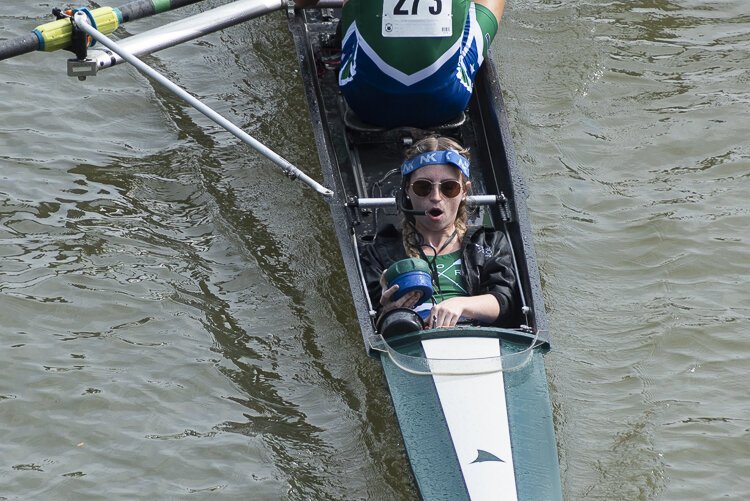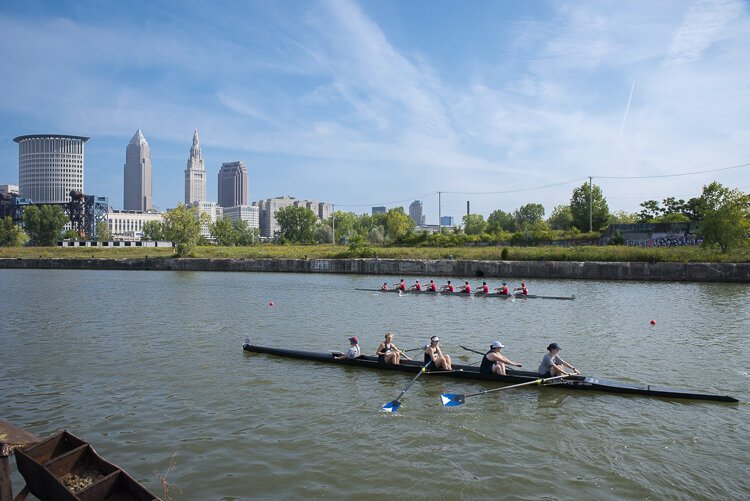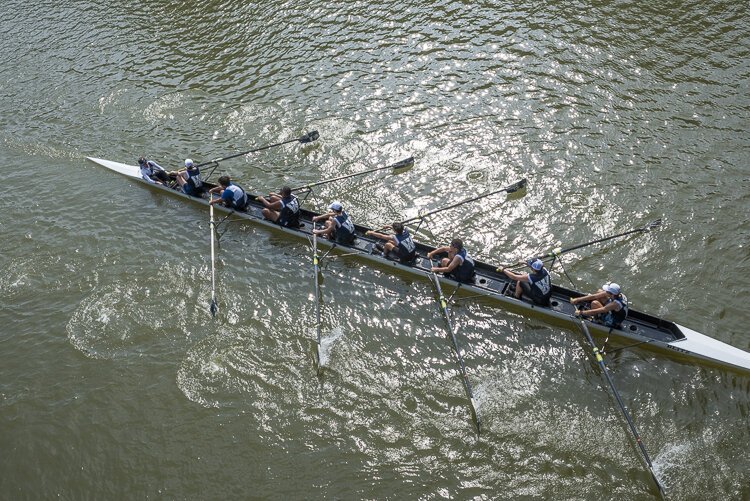Head of the Cuyahoga: Proof of progress, more activity on a thriving river
At Rivergate Park on the Cuyahoga River—a place that decades ago was a somewhat abandoned part of Cleveland near where the river famously caught fire in 1969—about 50 students from Case Western Reserve University (CWRU) crew team are working out in late August on the ergometers (ergs), indoor rowing workout machines in the Cleveland Rowing Foundation buildings on British Street in the old Irishtown Bend section of The Flats.
 Many team members are freshmen who are trying hard get to be “novices” in their first year at the university, meaning they might practice their rowing on the river, but are unlikely to compete for the team for a couple of years later.
Many team members are freshmen who are trying hard get to be “novices” in their first year at the university, meaning they might practice their rowing on the river, but are unlikely to compete for the team for a couple of years later.
There are about six Cleveland high schools also competing, and juniors in an interschool program work out nearby at The Foundry on Columbus Road. There are also three college teams—Cleveland State University, John Carroll University and CRWU—that compete at the nonprofit world-class rowing facility that makes rowing accessible to youth of all income levels in Cleveland.
The Cleveland Rowing foundation estimates that 1,500 local rowers participate annually in the sport, with the most sizable action being the amateur leagues that have formed in recent years.
In some ways, rowing has become a modern-day version of Beer League Softball—an activity that has flourished in places like Northeast Ohio because it combines staying in shape with friendly competitions. Of course, it is followed by beer drinking in bars that often sponsor the teams.
One of the principal annual rowing events in Cleveland occurs this Saturday, Sept. 17 with the 26th Head of the Cuyahoga (HOTC), a three-mile regatta on the river and one of the most popular rowing competitions in the United States.
The regatta starts near where I-490 crosses the Cuyahoga River (close to where the 1969 river fire occurred) and finishes at Rivergate Park near the Detroit-Superior Bridge.
The HOTC this year will have about 2,000 rowers from about 15 states and Canada and will be 4,900 meters long (about three miles). The scullers will pass beneath seven different bridges, have to navigate five challenging turns, and finish in an historic urban downtown area with a background that adds much to the whole experience.
Back in the Cleveland Rowing Foundation erg room in late August, the novices are working out in front of upperclassmen rowers and coaches. Kate Caforio, a CWRU senior from suburban Chicago studying healthcare, is the president of the school’s rowing club. As she watches the new rowers work out, she recalls how she had no rowing experience when she took the sport up as a freshman and is so thankful now that she did.
“It was something different for me, as I had played some sports in high school, but I’m not really an athlete if you are thinking of college-level scholarship type,” Caforio says. “But joining up [for the rowing club crew] was a great move on my part. It was a club, but really had the whole combination of athleticism and the workout regimens of being a varsity sport.”
Caforio adds the rowing is definitely a team sport, “because you have to sync up with those rowing with you,” she says. “And it really is a full-body sport, using your arms to move the oars and your lower body for the power.”
Derick Casiano came to CWRU from Richmond, Indiana and will graduate this year as a public health major. He is secretary of the rowing club.
“When I was coming to Cleveland for school, I was like everyone else—not really knowing anyone and not knowing the city much at all either,” Casiano recalls. “I was like Kate as well, playing soccer and running track in high school, but not college level in those either. But it has been great. I’ve met so many people doing this, other students and people who are from the city. Rowing is big here, and I am so glad I did this.”
 Caforio says she is looking forward to competing this year in the HOTC. “It’s always fun to compete, but even better when you are doing it home in front of people who are coming here to race from all over the country,” she says. “It is challenging with all those turns for most rowers, but we row in it all the time, so we have a home field advantage. That’s the fun part.”
Caforio says she is looking forward to competing this year in the HOTC. “It’s always fun to compete, but even better when you are doing it home in front of people who are coming here to race from all over the country,” she says. “It is challenging with all those turns for most rowers, but we row in it all the time, so we have a home field advantage. That’s the fun part.”
Longtime rower and Cleveland attorney Tim Marcovy says he likes the challenges involved in the Head of the Cuyahoga. “This race is very different from the rest of them in the country, because no other race has as many twists and turns as [the HOTC] does,” he says. “And what we’ve found is that the roots that rowing has put down in Cleveland is a realistic symbol of those twists and turns, because the sense of history and growth of this sport has had a very positive effect on Cleveland in many ways.”
The regatta that started a movement
Those twists and turns that Marcovy mentions has moved HOTC up from a trendy little sport that always had what was perceived as an elite and esoteric country club base into an activity that has about 1,000 league rowers every summer and an annual event that pumps about $1 million into the local economy, according to Catherine Gannon, board president of the Western Reserve Rowing Association (WRRA).
What started as small group of rowers back in the early 1980s, The Cleveland Rowing Foundation’s HOTC has morphed into one of the country's top ten largest, single-day head races that has occurred since 1996.
A little-known fact: The HOTC started in Lake Erie inside the breakwall downtown in 1989 before it moved to the river, because bad weather and high wind wave action made the race difficult.
Rowing has become an important part of the environmental movement as well because people see the need to fix and care for an urban river when they are constantly on the river that helped spark the formation of the Environmental Protection Agency (EPA).
 CWRU crew coach Aaron Marcovy (and son of Tim Marcovy), and longtime international rower himself, says being on the river brings the pollution concerns to the forefront.
CWRU crew coach Aaron Marcovy (and son of Tim Marcovy), and longtime international rower himself, says being on the river brings the pollution concerns to the forefront.
“When you are four inches above the surface of the water, you are very aware of the environmental issues in that area,” he says. “You can see if there is garbage in the river and if it smells really bad. You work to change that if it is that way, and you spread the word among you friends and family.”
When Rivergate Park was created about a decade ago near the vertical lift Columbus Road Bridge over the Cuyahoga River, in part to accommodate the rowing interests, the surrounding areas have become the focus of both cleaning up the Flats and drawing more people to it.
The effort has led to the establishment of more business activity and investment in property nearby.
This is where Ohio City, the Flats, downtown Cleveland, the lakefront, and the network of trails in the Cleveland Foundation Centennial Lake Link Trail connect to the 23-acre Irishtown Bend riverfront to form a park of its own.
Cleveland Ward 3 City Council member Kerry McCormack says he thinks the growing rowing activity on the river has been a huge catalyst in the “reconnection” Cleveland has with its river.
“There is no doubt about it, that the growth of rowing in Cleveland is one of the centerpieces and an exciting component of what is happening now in the city,” McCormack says. “What I find interesting is that it just isn’t the rowers in the river. It is the people who come to Merwin’s Wharf to eat outside and watch the rowers, it is the people who launch their own kayaks into the river, the [paddle board] people, the business community investing in a part of the city that wasn’t a hotspot for many years.”
 A gathering place
A gathering place
McCormack says he is pleasantly surprised by the impact rowing has had on the city.
“I doubt anyone 30 years ago would have speculated that people rowing on the Cuyahoga River would have such a long-term effect on the city in so many ways, but it has,” he says. “And it continues to grow. That’s what is exciting for all of us in Cleveland. Something we can all be proud of.”
The interest in rowing has also spawned other events. The Blazing Paddles Paddlefest, put on by local nonprofit Share the River, drew about 600 paddlers to the river in July. Share the River founder, Jim Ridge, says the change he is seeing is how the city views recreational use of the river.
“Cleveland has always been trying to find ways to reconnect with the river, and that reconnection with people using the river has brought people down to this area, brought about the Rivergate Park, made a restaurant like Merwin’s Wharf viable, connected the Tow Path trail between the lake and the Steelyard Commons area south, and spurred some the real estate and business investment in this area,” Ridge says.
Sean Terry, state director for the Ohio branch of the Trust for Public Land, which was instrumental in putting the Rivergate Park land acquisition together, echoes Ridge’s view of rowing as big plus: “The rowing activity is a common factor all those things share.”
What this means for the HOTC is that it may expand from a single-day event to two days within the next few years. The restriction that the COVID-19 pandemic put on all public events for the past few years have pushed expansion plans back a bit but talks with ore carriers and the business community to get their permission for an extra day of limiting their river usage are already started, according to Catherine Gannon, board president of the WRRA.
“What the city is finding is that [the HOTC] shows off the city to those who travel here, but it has expanded its importance beyond just the rowers,” Gannon says. “It is a good crowd of people who tell their family and friends about what a great time they had in a great city. The PR for the city is priceless.”
Aaron Marcovy understands all this as he watched those getting on the “ergs” as they try out for the CWRU crew club in late August. “I’ve rowed all over the world,” he says, “and the difference in Cleveland now is that we value the waterways much differently now. The industrial stakeholders like the steel industry and people the use the river as a recreation area—like the rowers—are now seeing we have similar goals, and we work together.”
CWRU senior Caforio understands some of what Marcovy is saying, but the history of what rowing was like 30 years ago in Cleveland—and what the Cuyahoga was like back then—doesn’t have the same impact on her as it does on her coach.
But Caforio does understand what the HOTC means, at least from a rower's perspective.
“Some of the best rowers in the country come here, there will be big crowds watching it all, and we want to win,” she says. “That’s what this is about, right?”








